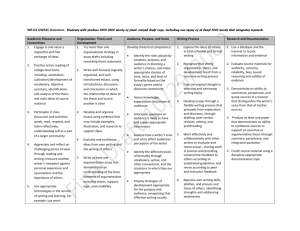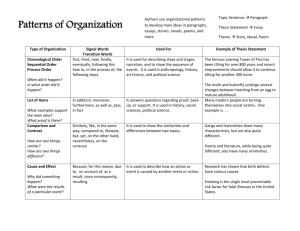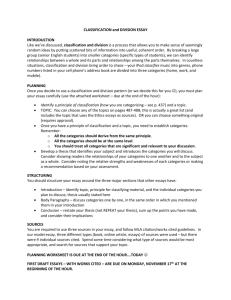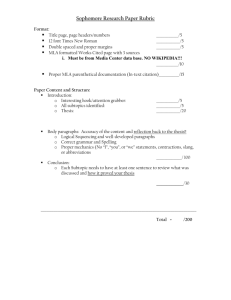English Composition*Exposition
advertisement
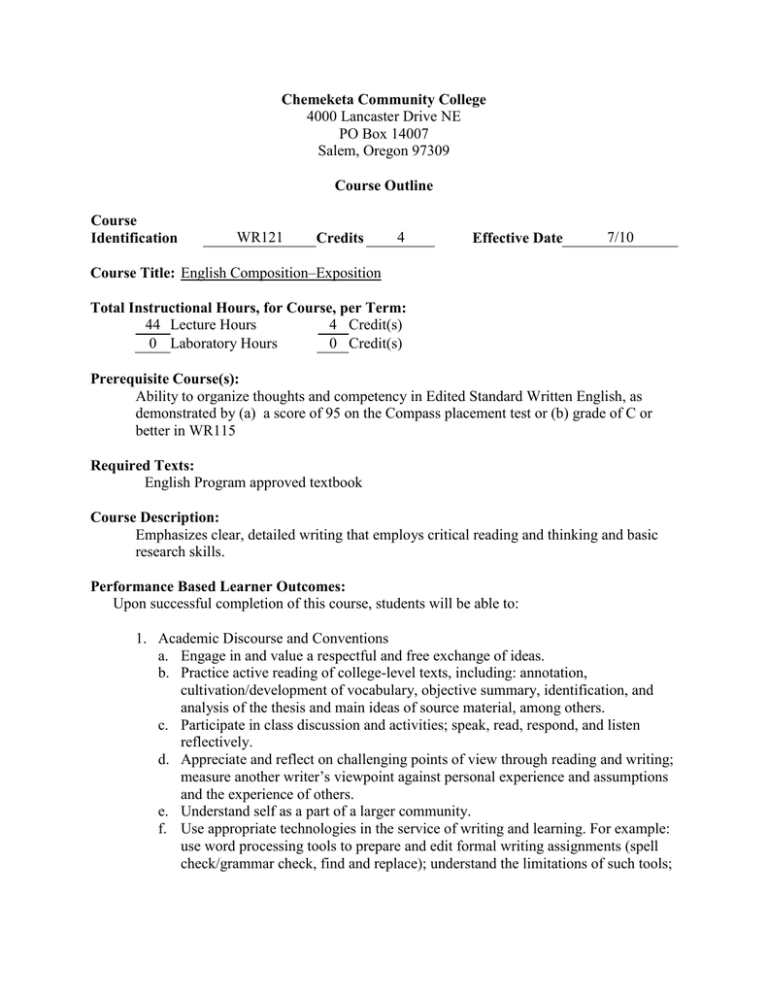
Chemeketa Community College 4000 Lancaster Drive NE PO Box 14007 Salem, Oregon 97309 Course Outline Course Identification WR121 Credits 4 Effective Date 7/10 Course Title: English Composition–Exposition Total Instructional Hours, for Course, per Term: 44 Lecture Hours 4 Credit(s) 0 Laboratory Hours 0 Credit(s) Prerequisite Course(s): Ability to organize thoughts and competency in Edited Standard Written English, as demonstrated by (a) a score of 95 on the Compass placement test or (b) grade of C or better in WR115 Required Texts: English Program approved textbook Course Description: Emphasizes clear, detailed writing that employs critical reading and thinking and basic research skills. Performance Based Learner Outcomes: Upon successful completion of this course, students will be able to: 1. Academic Discourse and Conventions a. Engage in and value a respectful and free exchange of ideas. b. Practice active reading of college-level texts, including: annotation, cultivation/development of vocabulary, objective summary, identification, and analysis of the thesis and main ideas of source material, among others. c. Participate in class discussion and activities; speak, read, respond, and listen reflectively. d. Appreciate and reflect on challenging points of view through reading and writing; measure another writer’s viewpoint against personal experience and assumptions and the experience of others. e. Understand self as a part of a larger community. f. Use appropriate technologies in the service of writing and learning. For example: use word processing tools to prepare and edit formal writing assignments (spell check/grammar check, find and replace); understand the limitations of such tools; Course Outline WR121 Page 2 locate course materials and resources online; and use online communication tools such as e-mail. g. Word process and format final drafts with appropriate headings, titles, spacing, margins, demonstrating an understanding of MLA citation style. h. Demonstrate the ability to use Edited Standard Written English to address an academic audience. i. Use a writer’s handbook and/or other resource for style, grammar, and citations. j. Manage prerequisite skills such as grammar, sentence variety, and word choice. 2. Organization, Thesis, and Development a. Try more than one organizational strategy in essay drafts including reworking thesis statement Write well-focused, logically organized, and well-transitioned essays, using introductions, discussion, and conclusions in which the relationship of ideas to the thesis and to one another is clear. b. Develop and organize essays using evidence that may include examples, illustration, and research to support ideas. c. Develop and organize essays using evidence that may include examples, illustration, and research to support ideas. d. Evaluate and synthesize ideas from own writing and the writing of others. e. Write at least one argumentative essay that demonstrates an understanding of the basic elements of formal argumentation including claims, support, logic, and credibility. f. Write argumentative essays that integrate research. 3. Audience, Purpose, and Voice (Develop Rhetorical Competence): a. Identify the roles played by situation, purpose, and audience in directing a writer’s choices, and make appropriate choices of tone, voice, and level of formality. b. Assess knowledge, expectations and biases of audiences. c. Anticipate questions an audience is likely to have and supply appropriate information. d. Identify the different levels of formality through vocabulary, syntax, and other conventions, and the situations in which they are appropriate. e. Employ strategies of development appropriate for the purpose and audience, recognizing that effective writing usually involves combinations of organizational strategies, including finding and integrating outside source material. 4. Writing Process a. Explore the ideas of others in both informal and formal writing. b. Recognize that strong organization, thesis, and development result from a recursive writing process. c. Exercise original thought in selecting and narrowing writing topics d. Develop essays through a flexible writing process that proceeds from exploration and discovery, through drafting, peer review, revision, editing, and proofreading. Course Outline WR121 Page 3 e. Work effectively and collaboratively with other writers to evaluate and revise essays, sharing work in process and providing constructive feedback to others according to established guidelines, and revise according to peer and instructor feedback. f. Appraise own writing skills, abilities, and process and those of others, identifying strengths and addressing weaknesses. g. Use available writing assistance. 5. Research and Documentation a. Use the library, a database, and the Internet to locate information and evidence. b. Evaluate source materials for authority, currency, reliability, bias, sound reasoning and validity of evidence. c. Demonstrate an ability to summarize, paraphrase, and quote sources in a manner that distinguishes the writer’s voice from that of his/her sources. d. Produce at least one paper that demonstrates an ability to synthesize sources to support an assertive or argumentative thesis through summary, paraphrase, and integrated quotation. e. Format citations and bibliographic information in more than one documentation style using the handbook. f. Integrate research as support for their own ideas with proper MLA or APA documentation. Note: Students must write between 4,000-5,000 words of final, revised draft copy, including one argumentative essay of at least 1,000 words that integrates research. Course Content Outline: I. II. Academic Discourse and Conventions A. Guided discussion and model practices that help students listen to, reflect upon, and respond to the ideas of others B. Reading of a variety of texts including peer writing C. College-level readings that challenge students and require analysis of complex ideas D. Accessing grammatical, usage, and punctuation rules in handbook E. Accessing course materials in non-print media Organization, Thesis, and Development A. Review of standard essay structure B. Approaches to beginnings and endings C. Unity and coherence: transitions and connections to thesis statement D. Thesis statements and topic sentences that establish content boundaries E. Use of evidence from personal experience and sources F. Basic elements of formal argumentation including claims, support, and logic Course Outline WR121 Page 4 III. IV. V. Audience, Purpose, and Voice A. Assessment of audience B. Recognition of the interaction of situation, purpose, and audience C. Anticipation of audience’s needs in terms of language and development D. Levels of formality: word choice appropriate to intended reader and purpose E. Style F. Voice Writing Process A. Determining purpose B. Prewriting C. Drafting D. Developing thesis E. Revising F. Editing G. Proofreading Research and Documentation A. Location of models for citations and bibliographic information in the handbook B. Formatting citation and bibliographic information in MLA and at least one other documentation style C. Use of signal phrases to introduce quotations D. Summary, paraphrase, and direct quotation E. Identification of resource material 1. Library 2. Databases 3. Internet F. Credibility of resources 1. Authority 2. Currency 3. Reliability 4. Bias 5. Sound reasoning G. Integration of research as support for their ideas with proper MLA or APA documentation

